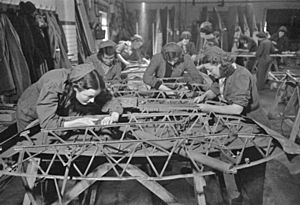Civilian Repair Organisation facts for kids
The Civilian Repair Organisation (CRO) was a special group in Britain during World War II. It was created in 1939 to fix and maintain military aircraft. Civilian companies and workers did this important job. The CRO helped keep Britain's planes flying during the war.
It's important not to confuse it with another group called the Civil Repair Organisation. That group did similar work for Britain's Air Ministry in India from 1943 to 1945.
Contents
How the Civilian Repair Organisation Helped in World War II
Starting the CRO: A Wartime Idea
After World War II began, Britain needed a way to repair its military planes quickly. So, on September 11, 1939, the first Civilian Repair Unit (CRU) was set up. It was located at the Cowley works of Morris Motors. Civilians worked there, managed by the Air Ministry.
On October 6, 1939, Sir Kingsley Wood, who was in charge of the Air Ministry, made an important appointment. He chose William Morris (Lord Nuffield) to lead the new Civilian Repair Organisation (CRO). Lord Nuffield was already a famous car maker. He had also been in charge of a "shadow factory" at Castle Bromwich that built aircraft.
The main office for the CRO was set up at Magdalen College, Oxford. Later, on May 14, 1940, the CRO moved under the control of a new government department. This was the Ministry of Aircraft Production, led by Lord Beaverbrook.
How Aircraft Were Repaired
The No.1 CRU at Cowley got extra help from the No.1 Metal and Produce Recovery Depot (MPRD). This depot was right next to the Cowley works. It helped to reclaim materials from damaged planes.
A support team, No.50 Maintenance Unit (MU), was also based at Cowley. Their job was to move damaged aircraft and parts to the CRU. They also took non-repairable parts and scrap to the MPRD for recycling. These Maintenance Units were part of the RAF Maintenance Command.
Many civilian companies helped the CRO. These were often businesses that already built or repaired aircraft in the UK. Other companies from engineering and woodworking also joined in.
Aircraft repairs often happened in different factories spread out across the country. Once fixed, the parts or whole planes were sent to airfields. There, they were put back together and tested. After testing, they were returned to the RAF units.
For small repairs, planes could even fly directly to a CRO company at an airfield. They would be fixed quickly and could fly out the next day. These fast repairs were known as "Fly In" repairs.
Amazing Results: The CRO's Impact
Between May 1940 and July 1945, the Civilian Repair Organisation did incredible work. They returned a total of 79,000 aircraft to active service. This meant these planes could fly and fight again.
By July 1945, a large number of the RAF's heavy aircraft had been repaired by the CRO. About 36.5% of them, which was 3,285 planes, had gone through the CRO's repair process. The CRO continued its important work for several years even after World War II ended.


